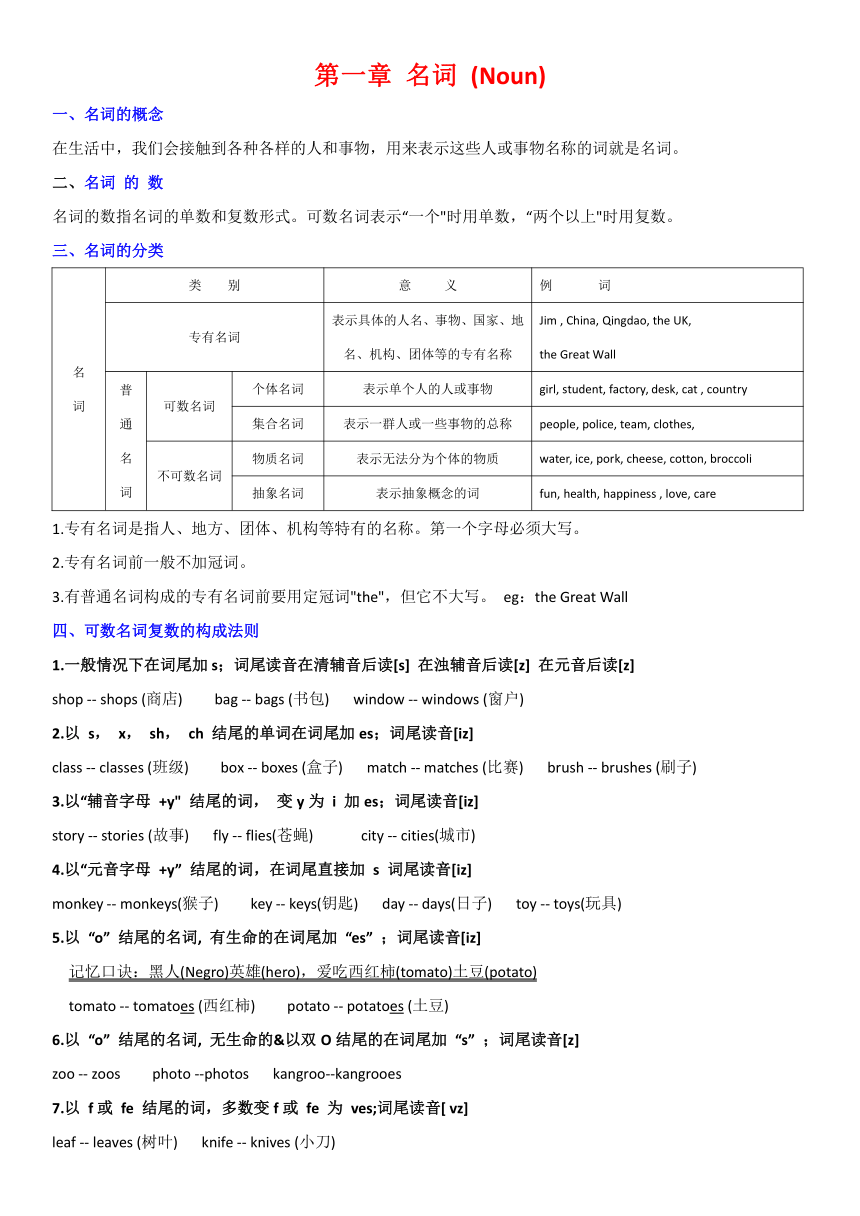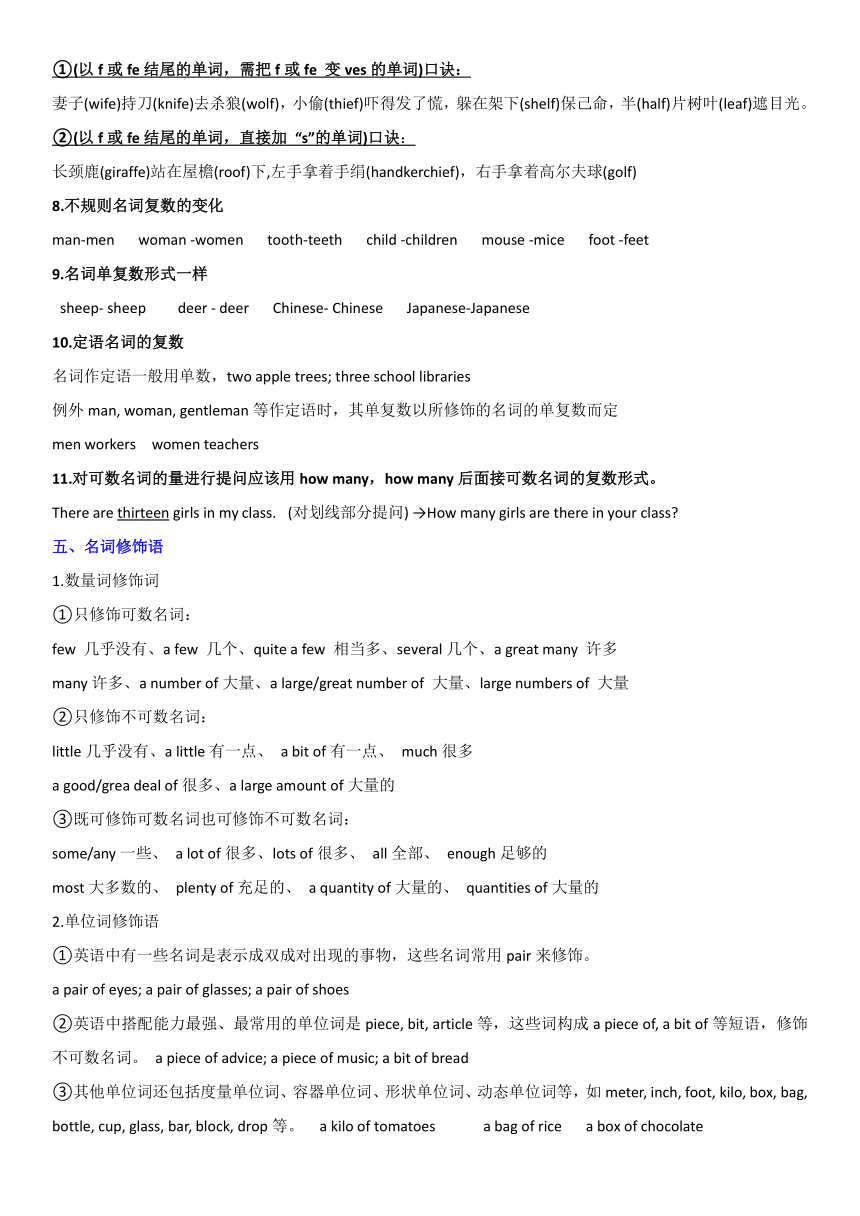2024年人教版英语九年级全册 名词讲解(一)
文档属性
| 名称 | 2024年人教版英语九年级全册 名词讲解(一) |  | |
| 格式 | docx | ||
| 文件大小 | 28.5KB | ||
| 资源类型 | 教案 | ||
| 版本资源 | 人教新目标(Go for it)版 | ||
| 科目 | 英语 | ||
| 更新时间 | 2024-10-16 16:11:45 | ||
图片预览


文档简介
第一章 名词 (Noun)
一、名词的概念
在生活中,我们会接触到各种各样的人和事物,用来表示这些人或事物名称的词就是名词。
名词 的 数
名词的数指名词的单数和复数形式。可数名词表示“一个"时用单数,“两个以上"时用复数。
三、名词的分类
名 词 类 别 意 义 例 词
专有名词 表示具体的人名、事物、国家、地名、机构、团体等的专有名称 Jim , China, Qingdao, the UK, the Great Wall
普 通 名 词 可数名词 个体名词 表示单个人的人或事物 girl, student, factory, desk, cat , country
集合名词 表示一群人或一些事物的总称 people, police, team, clothes,
不可数名词 物质名词 表示无法分为个体的物质 water, ice, pork, cheese, cotton, broccoli
抽象名词 表示抽象概念的词 fun, health, happiness , love, care
1.专有名词是指人、地方、团体、机构等特有的名称。第一个字母必须大写。
2.专有名词前一般不加冠词。
3.有普通名词构成的专有名词前要用定冠词"the",但它不大写。 eg:the Great Wall
四、可数名词复数的构成法则
1.一般情况下在词尾加 s;词尾读音在清辅音后读[s] 在浊辅音后读[z] 在元音后读[z]
shop -- shops (商店) bag -- bags (书包) window -- windows (窗户)
2.以 s, x, sh, ch 结尾的单词在词尾加es;词尾读音[iz]
class -- classes (班级) box -- boxes (盒子) match -- matches (比赛) brush -- brushes (刷子)
3.以“辅音字母 +y" 结尾的词, 变y为 i 加es;词尾读音[iz]
story -- stories (故事) fly -- flies(苍蝇) city -- cities(城市)
4.以“元音字母 +y” 结尾的词,在词尾直接加 s 词尾读音[iz]
monkey -- monkeys(猴子) key -- keys(钥匙) day -- days(日子) toy -- toys(玩具)
5.以 “o” 结尾的名词, 有生命的在词尾加 “es” ;词尾读音[iz]
记忆口诀:黑人(Negro)英雄(hero),爱吃西红柿(tomato)土豆(potato)
tomato -- tomatoes (西红柿) potato -- potatoes (土豆)
6.以 “o” 结尾的名词, 无生命的&以双O结尾的在词尾加 “s” ;词尾读音[z]
zoo -- zoos photo --photos kangroo--kangrooes
7.以 f或 fe 结尾的词,多数变f或 fe 为 ves;词尾读音[ vz]
leaf -- leaves (树叶) knife -- knives (小刀)
①(以f或fe结尾的单词,需把f或fe 变ves的单词)口诀:
妻子(wife)持刀(knife)去杀狼(wolf),小偷(thief)吓得发了慌,躲在架下(shelf)保己命,半(half)片树叶(leaf)遮目光。
②(以f或fe结尾的单词,直接加 “s”的单词)口诀:
长颈鹿(giraffe)站在屋檐(roof)下,左手拿着手绢(handkerchief),右手拿着高尔夫球(golf)
8.不规则名词复数的变化
man-men woman -women tooth-teeth child -children mouse -mice foot -feet
9.名词单复数形式一样
sheep- sheep deer - deer Chinese- Chinese Japanese-Japanese
10.定语名词的复数
名词作定语一般用单数,two apple trees; three school libraries
例外man, woman, gentleman等作定语时,其单复数以所修饰的名词的单复数而定
men workers women teachers
11.对可数名词的量进行提问应该用how many,how many后面接可数名词的复数形式。
There are thirteen girls in my class. (对划线部分提问) →How many girls are there in your class
五、名词修饰语
1.数量词修饰词
①只修饰可数名词:
few 几乎没有、a few 几个、quite a few 相当多、several几个、a great many 许多
many许多、a number of大量、a large/great number of 大量、large numbers of 大量
②只修饰不可数名词:
little几乎没有、a little有一点、 a bit of有一点、 much很多
a good/grea deal of很多、a large amount of大量的
③既可修饰可数名词也可修饰不可数名词:
some/any一些、 a lot of很多、lots of很多、 all全部、 enough足够的
most大多数的、 plenty of充足的、 a quantity of大量的、 quantities of大量的
2.单位词修饰语
①英语中有一些名词是表示成双成对出现的事物,这些名词常用pair来修饰。
a pair of eyes; a pair of glasses; a pair of shoes
②英语中搭配能力最强、最常用的单位词是piece, bit, article等,这些词构成a piece of, a bit of等短语,修饰不可数名词。 a piece of advice; a piece of music; a bit of bread
③其他单位词还包括度量单位词、容器单位词、形状单位词、动态单位词等,如meter, inch, foot, kilo, box, bag, bottle, cup, glass, bar, block, drop等。 a kilo of tomatoes a bag of rice a box of chocolate
六、不可数名词
(1)不可数名词作主语,谓语动词用第三人称单数形式。
Knowledge is power.知识就是力量。 Water is a liquid .水是液体。
(2)由some,a little,much,little等词修饰。 They have much money.他们存了很多钱。
(3)与表示单位的量词如a piece of等连用。 Go and fetch me a piece of chalk.给我去拿一支粉笔。
不可数名词可以与量词使用构成不同的词组:
a piece of paper 一张纸 a drop of water 一滴水 a loaf of bread 一条面包
a bottle of milk 一瓶牛奶 a pair of shoes 一双鞋 two pieces of paper两张纸
注意的是:不可数名词不能与不定冠词或数词直接用在一起。不能说a good news, an advice等。
(5)不可数名词一般无复数形式。部分物质名词在表不同类别时,可用复数形式。
fishes(各种各样的鱼), newspapers(各种报纸), waters(河湖、海水), snows(积雪)……
(6)有些抽象名词也常用复数,变为可数的具体的事物。 times 时代,works 著作,difficulties 困难
(7)常见的不可数名词
①物质名词:snow(雪),rain(雨),water(水),coffee(咖啡),tea(茶),meat (肉),
milk(牛奶),rice(米饭),bread(面包),orange (桔子汁)等;
②抽象名词:work(工作),study(学习),love(爱),friendship (友谊)等;
(8)对不可数名词的量进行提问应该用how much,how much后接不可数名词。
Peter had one cup of ice-cream just now. (对划线部分提问) →How much ice-cream did Peter have just now
七、名词所有格
1.名词的所有格用以表示名词之间的所有关系。主要有of和's两种表示方式。
2.表示有生命的事物的名词及某些表示时间、距离等无生命的东西的名词后加's来表示所有关系。
3.表示多数无生命的事物的名词之间使用of进行连接。
名词所有格的构成规则如下
-’s所有格
(1)一般情况在名词后加's
Jimmy's book吉米的书 Wuhan's summer is very hot. 武汉的夏天非常热。
Qianqian's mother倩倩的妈妈 Qianqian's math is very good. 倩倩的数学很好。
(2)在以s结尾的名词(包括以s结尾的复数名词)后面只加'
Today is September 10th, Teachers' Day.今天是九月十日,教师节。
Twins' father is Mr. Brown.双胞胎的爸爸是布朗先生。
Girls' favorite food is ice-cream.女孩们最喜欢的食物是冰激凌。
如果复数名词不是以s结尾的,末尾也要加's
Women's clothes 女装 men's room 男厕所 Children's Day is coming.儿童节马上就要到了
(4)'s所有格所修饰的词的省略现象
①表示店铺、教堂、医院、学校等建筑的名词的-’s所有格后常省略被修饰的名词
(此时所有格表示相应的场所,且一般要在所有格名词前加定冠词the)。
I met her at the doctor's(office).我在诊所遇见了她。
My father and I will have dinner at the Johnson's. (home) 我爸爸和我将要去约翰逊的家吃晚饭。
We will have our hair cut at the barber's (shop)tomorrow afternoon.明天下午我们要去理发店理发。
②有时为了避免重复,如果一个被-’s所有格修饰的名词在上文已经提到过,或两个-’s所有格所修饰的词
相同,往往可以省略第二个所有格后的名词。
The bike is not mine,but Wang Pinpin's.这辆自行车不是我的,是王品品的。
This Teddy bear is nor Jane’s doll, but Lily’s (doll).
③在人名后的所有格省略名词时,表示某人的住宅。
go to my sister’s (去我姐姐家) at my uncle’s(在我叔叔家)
(5)表示时间、距离、重量、金额、天体、国家或城市等无生命事物的名词,也可用-’s所有格。
Beijing's spring北京的春天 the city's parks城市公园
I bought ten dollars’ worth of stamps. 我买了十美元的邮票。
There is something important in today's newspaper. 今天的报纸上有一些重要的东西。
It's about ten minutes' walk from my home to my school. 从我家到我学校大概10分钟的步行路程。
(6)表示集体或机构等的名词
That’s the majority’s view, I think. 我想这是多数人的意见。
We sat in the station’s waiting-room until evening. 我们在车站候车室等到晚上。
She teaches at Harvard’s Department of Linguistics. 她在哈佛大学语言学系任教授。
(7)特殊所有格
(各自拥有,分别加's ) Lucy's and Lily's mothers.(指两个人各自的妈妈,两个妈)
(共同拥有,最后加's) Lucy and Lily's mother. (指两人共同的妈妈,一个妈)
an hour and a half's walk (步行一个半小时的路程)
of所有格
(1)一般来说,of所有格表示无生命的名词的所有关系。
the window of the room房间的窗户 the beginning of the story故事的开头
the cover of the book 书的封皮 the gate of the school 学校的大门
用于有生命的东西,尤其是有较长定语时。
the classrooms of the first-year students
(3)地名、交通工具名及与人的活动有关的无生命名词可用of所有格,也可用-’s所有格。
China’s future = the future of China the girl’s name = the name of the girl
(4)双重所有格 双重所有格的构成有两种形式:①of+-’s所有格;②of+名词性物主代词
①名词+of+'s所有格。
He is a friend of my sister's.(= one of my sister's friends)他是我姐姐的一个朋友
Look at that long nose of Jack's.看杰克的那个长鼻子。(感彩)
②名词+of+名词性物主代词。
a good friend of mine 我的一个好朋友 an interesting story of his 他的有趣的经历
of前的名词常有冠词、数词、不定代词等修饰,带 ’s的所有格的名词必须是明确限定的、指人的。
This is a bag of my mother’s.
被双重所有格修饰的名词前有指示代词时,通常带有一定的感彩。
that big nose of Tom's汤姆的那个大鼻子
(5)注意:中心词(of前面)是picture,photo等时,用of所有格与双重所有格表示的意义有所不同。
①用of所有格修饰时,表示某人自己的肖像,照片等
a photo of Jane 简本人的一张照片(照片中的人是简)
②用双重所有格修饰时,表示有关人收藏的肖像,照片等
a photo of Jane's 简拥有的照片中的一张,不一定是她本人的照片
辨析
①She is Mary's brother's friend. ②She is a friend of Mary's brother.③She is a friend of Mary's brother's.
第1句用的是's所有格,侧重说明她和Mary的哥哥是朋友关系,突出friend一词。
第2句用的是of所有格,侧重说明她和Mary的哥哥是朋友关系,强调突出了Mary's brother。
第3句用的是双重所有格,侧重说明Mary哥哥的朋友不止是一个,她只是其中的一个。
注:其它多数情况下,无生命的名词一般不宜用's所有格,而应该用of表示所属关系。
比如,一般不宜说 the book's cover, 而应该说 the cover of the book。
表示有生命的名词,有时也可以用of所有格。the children of the family the life of a panda
但注意以下情况不宜用of所有格:
①被修饰的名词后有同位语时my friend's brother, a doctor my teacher's book, Romeo and Juliet
②名词有定语从句或介词短语等后置定语修饰时
The party's policy in education Tolstoy's novels that are still read today
③名词有并列成分时 the plant's technicians and workers Mr Smith's dictionary and textbook
一、名词的概念
在生活中,我们会接触到各种各样的人和事物,用来表示这些人或事物名称的词就是名词。
名词 的 数
名词的数指名词的单数和复数形式。可数名词表示“一个"时用单数,“两个以上"时用复数。
三、名词的分类
名 词 类 别 意 义 例 词
专有名词 表示具体的人名、事物、国家、地名、机构、团体等的专有名称 Jim , China, Qingdao, the UK, the Great Wall
普 通 名 词 可数名词 个体名词 表示单个人的人或事物 girl, student, factory, desk, cat , country
集合名词 表示一群人或一些事物的总称 people, police, team, clothes,
不可数名词 物质名词 表示无法分为个体的物质 water, ice, pork, cheese, cotton, broccoli
抽象名词 表示抽象概念的词 fun, health, happiness , love, care
1.专有名词是指人、地方、团体、机构等特有的名称。第一个字母必须大写。
2.专有名词前一般不加冠词。
3.有普通名词构成的专有名词前要用定冠词"the",但它不大写。 eg:the Great Wall
四、可数名词复数的构成法则
1.一般情况下在词尾加 s;词尾读音在清辅音后读[s] 在浊辅音后读[z] 在元音后读[z]
shop -- shops (商店) bag -- bags (书包) window -- windows (窗户)
2.以 s, x, sh, ch 结尾的单词在词尾加es;词尾读音[iz]
class -- classes (班级) box -- boxes (盒子) match -- matches (比赛) brush -- brushes (刷子)
3.以“辅音字母 +y" 结尾的词, 变y为 i 加es;词尾读音[iz]
story -- stories (故事) fly -- flies(苍蝇) city -- cities(城市)
4.以“元音字母 +y” 结尾的词,在词尾直接加 s 词尾读音[iz]
monkey -- monkeys(猴子) key -- keys(钥匙) day -- days(日子) toy -- toys(玩具)
5.以 “o” 结尾的名词, 有生命的在词尾加 “es” ;词尾读音[iz]
记忆口诀:黑人(Negro)英雄(hero),爱吃西红柿(tomato)土豆(potato)
tomato -- tomatoes (西红柿) potato -- potatoes (土豆)
6.以 “o” 结尾的名词, 无生命的&以双O结尾的在词尾加 “s” ;词尾读音[z]
zoo -- zoos photo --photos kangroo--kangrooes
7.以 f或 fe 结尾的词,多数变f或 fe 为 ves;词尾读音[ vz]
leaf -- leaves (树叶) knife -- knives (小刀)
①(以f或fe结尾的单词,需把f或fe 变ves的单词)口诀:
妻子(wife)持刀(knife)去杀狼(wolf),小偷(thief)吓得发了慌,躲在架下(shelf)保己命,半(half)片树叶(leaf)遮目光。
②(以f或fe结尾的单词,直接加 “s”的单词)口诀:
长颈鹿(giraffe)站在屋檐(roof)下,左手拿着手绢(handkerchief),右手拿着高尔夫球(golf)
8.不规则名词复数的变化
man-men woman -women tooth-teeth child -children mouse -mice foot -feet
9.名词单复数形式一样
sheep- sheep deer - deer Chinese- Chinese Japanese-Japanese
10.定语名词的复数
名词作定语一般用单数,two apple trees; three school libraries
例外man, woman, gentleman等作定语时,其单复数以所修饰的名词的单复数而定
men workers women teachers
11.对可数名词的量进行提问应该用how many,how many后面接可数名词的复数形式。
There are thirteen girls in my class. (对划线部分提问) →How many girls are there in your class
五、名词修饰语
1.数量词修饰词
①只修饰可数名词:
few 几乎没有、a few 几个、quite a few 相当多、several几个、a great many 许多
many许多、a number of大量、a large/great number of 大量、large numbers of 大量
②只修饰不可数名词:
little几乎没有、a little有一点、 a bit of有一点、 much很多
a good/grea deal of很多、a large amount of大量的
③既可修饰可数名词也可修饰不可数名词:
some/any一些、 a lot of很多、lots of很多、 all全部、 enough足够的
most大多数的、 plenty of充足的、 a quantity of大量的、 quantities of大量的
2.单位词修饰语
①英语中有一些名词是表示成双成对出现的事物,这些名词常用pair来修饰。
a pair of eyes; a pair of glasses; a pair of shoes
②英语中搭配能力最强、最常用的单位词是piece, bit, article等,这些词构成a piece of, a bit of等短语,修饰不可数名词。 a piece of advice; a piece of music; a bit of bread
③其他单位词还包括度量单位词、容器单位词、形状单位词、动态单位词等,如meter, inch, foot, kilo, box, bag, bottle, cup, glass, bar, block, drop等。 a kilo of tomatoes a bag of rice a box of chocolate
六、不可数名词
(1)不可数名词作主语,谓语动词用第三人称单数形式。
Knowledge is power.知识就是力量。 Water is a liquid .水是液体。
(2)由some,a little,much,little等词修饰。 They have much money.他们存了很多钱。
(3)与表示单位的量词如a piece of等连用。 Go and fetch me a piece of chalk.给我去拿一支粉笔。
不可数名词可以与量词使用构成不同的词组:
a piece of paper 一张纸 a drop of water 一滴水 a loaf of bread 一条面包
a bottle of milk 一瓶牛奶 a pair of shoes 一双鞋 two pieces of paper两张纸
注意的是:不可数名词不能与不定冠词或数词直接用在一起。不能说a good news, an advice等。
(5)不可数名词一般无复数形式。部分物质名词在表不同类别时,可用复数形式。
fishes(各种各样的鱼), newspapers(各种报纸), waters(河湖、海水), snows(积雪)……
(6)有些抽象名词也常用复数,变为可数的具体的事物。 times 时代,works 著作,difficulties 困难
(7)常见的不可数名词
①物质名词:snow(雪),rain(雨),water(水),coffee(咖啡),tea(茶),meat (肉),
milk(牛奶),rice(米饭),bread(面包),orange (桔子汁)等;
②抽象名词:work(工作),study(学习),love(爱),friendship (友谊)等;
(8)对不可数名词的量进行提问应该用how much,how much后接不可数名词。
Peter had one cup of ice-cream just now. (对划线部分提问) →How much ice-cream did Peter have just now
七、名词所有格
1.名词的所有格用以表示名词之间的所有关系。主要有of和's两种表示方式。
2.表示有生命的事物的名词及某些表示时间、距离等无生命的东西的名词后加's来表示所有关系。
3.表示多数无生命的事物的名词之间使用of进行连接。
名词所有格的构成规则如下
-’s所有格
(1)一般情况在名词后加's
Jimmy's book吉米的书 Wuhan's summer is very hot. 武汉的夏天非常热。
Qianqian's mother倩倩的妈妈 Qianqian's math is very good. 倩倩的数学很好。
(2)在以s结尾的名词(包括以s结尾的复数名词)后面只加'
Today is September 10th, Teachers' Day.今天是九月十日,教师节。
Twins' father is Mr. Brown.双胞胎的爸爸是布朗先生。
Girls' favorite food is ice-cream.女孩们最喜欢的食物是冰激凌。
如果复数名词不是以s结尾的,末尾也要加's
Women's clothes 女装 men's room 男厕所 Children's Day is coming.儿童节马上就要到了
(4)'s所有格所修饰的词的省略现象
①表示店铺、教堂、医院、学校等建筑的名词的-’s所有格后常省略被修饰的名词
(此时所有格表示相应的场所,且一般要在所有格名词前加定冠词the)。
I met her at the doctor's(office).我在诊所遇见了她。
My father and I will have dinner at the Johnson's. (home) 我爸爸和我将要去约翰逊的家吃晚饭。
We will have our hair cut at the barber's (shop)tomorrow afternoon.明天下午我们要去理发店理发。
②有时为了避免重复,如果一个被-’s所有格修饰的名词在上文已经提到过,或两个-’s所有格所修饰的词
相同,往往可以省略第二个所有格后的名词。
The bike is not mine,but Wang Pinpin's.这辆自行车不是我的,是王品品的。
This Teddy bear is nor Jane’s doll, but Lily’s (doll).
③在人名后的所有格省略名词时,表示某人的住宅。
go to my sister’s (去我姐姐家) at my uncle’s(在我叔叔家)
(5)表示时间、距离、重量、金额、天体、国家或城市等无生命事物的名词,也可用-’s所有格。
Beijing's spring北京的春天 the city's parks城市公园
I bought ten dollars’ worth of stamps. 我买了十美元的邮票。
There is something important in today's newspaper. 今天的报纸上有一些重要的东西。
It's about ten minutes' walk from my home to my school. 从我家到我学校大概10分钟的步行路程。
(6)表示集体或机构等的名词
That’s the majority’s view, I think. 我想这是多数人的意见。
We sat in the station’s waiting-room until evening. 我们在车站候车室等到晚上。
She teaches at Harvard’s Department of Linguistics. 她在哈佛大学语言学系任教授。
(7)特殊所有格
(各自拥有,分别加's ) Lucy's and Lily's mothers.(指两个人各自的妈妈,两个妈)
(共同拥有,最后加's) Lucy and Lily's mother. (指两人共同的妈妈,一个妈)
an hour and a half's walk (步行一个半小时的路程)
of所有格
(1)一般来说,of所有格表示无生命的名词的所有关系。
the window of the room房间的窗户 the beginning of the story故事的开头
the cover of the book 书的封皮 the gate of the school 学校的大门
用于有生命的东西,尤其是有较长定语时。
the classrooms of the first-year students
(3)地名、交通工具名及与人的活动有关的无生命名词可用of所有格,也可用-’s所有格。
China’s future = the future of China the girl’s name = the name of the girl
(4)双重所有格 双重所有格的构成有两种形式:①of+-’s所有格;②of+名词性物主代词
①名词+of+'s所有格。
He is a friend of my sister's.(= one of my sister's friends)他是我姐姐的一个朋友
Look at that long nose of Jack's.看杰克的那个长鼻子。(感彩)
②名词+of+名词性物主代词。
a good friend of mine 我的一个好朋友 an interesting story of his 他的有趣的经历
of前的名词常有冠词、数词、不定代词等修饰,带 ’s的所有格的名词必须是明确限定的、指人的。
This is a bag of my mother’s.
被双重所有格修饰的名词前有指示代词时,通常带有一定的感彩。
that big nose of Tom's汤姆的那个大鼻子
(5)注意:中心词(of前面)是picture,photo等时,用of所有格与双重所有格表示的意义有所不同。
①用of所有格修饰时,表示某人自己的肖像,照片等
a photo of Jane 简本人的一张照片(照片中的人是简)
②用双重所有格修饰时,表示有关人收藏的肖像,照片等
a photo of Jane's 简拥有的照片中的一张,不一定是她本人的照片
辨析
①She is Mary's brother's friend. ②She is a friend of Mary's brother.③She is a friend of Mary's brother's.
第1句用的是's所有格,侧重说明她和Mary的哥哥是朋友关系,突出friend一词。
第2句用的是of所有格,侧重说明她和Mary的哥哥是朋友关系,强调突出了Mary's brother。
第3句用的是双重所有格,侧重说明Mary哥哥的朋友不止是一个,她只是其中的一个。
注:其它多数情况下,无生命的名词一般不宜用's所有格,而应该用of表示所属关系。
比如,一般不宜说 the book's cover, 而应该说 the cover of the book。
表示有生命的名词,有时也可以用of所有格。the children of the family the life of a panda
但注意以下情况不宜用of所有格:
①被修饰的名词后有同位语时my friend's brother, a doctor my teacher's book, Romeo and Juliet
②名词有定语从句或介词短语等后置定语修饰时
The party's policy in education Tolstoy's novels that are still read today
③名词有并列成分时 the plant's technicians and workers Mr Smith's dictionary and textbook
同课章节目录
- Unit 1 How can we become good learners.
- Section A
- Section B
- Unit 2 I think that mooncakes are delicious!
- Section A
- Section B
- Unit 3 Could you please tell me where the restroom
- Section A
- Section B
- Unit 4 I used to be afraid of the dark.
- Section A
- Section B
- Unit 5 What are the shirts made of?
- Section A
- Section B
- Review of Units 1-5
- Unit 6 When was it invented?
- Section A
- Section B
- Unit 7 Teenagers should be allowed to choose their
- Section A
- Section B
- Unit 8 It must belong to Carla.
- Section A
- Section B
- Unit 9 I like music that I can dance to.
- Section A
- Section B
- Unit 10 You're supposed to shake hands.
- Section A
- Section B
- Review of Units 6-10
- Unit 11 Sad movies make me cry.
- Section A
- Section B
- Unit 12 Life is full of the unexpected
- Section A
- Section B
- Unit 13 We're trying to save the earth!
- Section A
- Section B
- Unit 14 I remember meeting all of you in Grade 7.
- Section A
- Section B
- Review of Units 11-14
